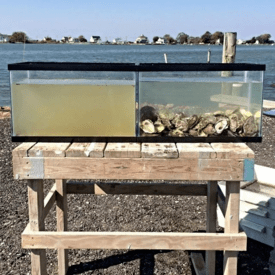
Environmental educators in Pensacola are acquainting kids with water filtration in a new, hands-on way. Instead of a class turtle, these students are raising baby oysters. This program is sponsored by the Pensacola Bay Oyster Company and supports a local nonprofit, the Bream Fisherman Association, in its efforts to educate a new generation on marine wildlife preservation. Students contribute to the efforts to expand oyster populations in Pensacola Bay by purchasing and raising baby oysters (spat). It is a challenging and rewarding task, as baby oysters are not easily cared for. They are sensitive to salinity and other environmental changes, and must be maintained in the proper environment 2 feet below the water’s surface. The juvenile oyster cages must be periodically monitored and cleaned. Only after nine months of attention are the oysters mature enough to be placed in reefs or farms.
Oysters are an integral part of marine ecosystems, serving as an ecosystem engineer and enhancing biodiversity by improving water quality. While filter feeding, adult oysters can each process one to two gallons of water per hour, during which they remove algae, plankton, and other particles that impact water clarity. Oysters may also potentially mitigate the effects of nutrient pollution in coastal waters by fixing nitrogen and phosphorous in their shells, tissues and excrement.
Scientists continue to investigate oysters as natural water filters. In a recent 2015 study, waste oyster shells were shown to be better than gravel at purifying domestic water supplies from nitrogen and aerobic organisms. In another study, a restored oyster reef in a Maryland river was found to remove 20 times more nitrogen from water than a neighboring oyster-free site. And an EPA-funded study carried out by Virginia Commonwealth University researchers estimated that large-scale oyster farms can bio-assimilate almost 300 lbs of nitrogen and over 40 lbs of phosphorous in the Chesapeake Bay per harvest of 1,000,000 oysters.
Oysters alone cannot save polluted marine habitats, but they certainly have a part to play as tiny powerful water filters. See the video below for a time-lapse of oysters in action.


![Join Sterlitech at BIO 2024 [Booth #5558]: Exploring the Future of Biotechnology](https://www.sterlitech.com/media/magefan_blog/b4.jpeg)

